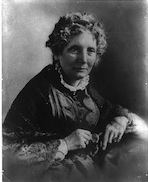STOWE, HARRIET BEECHER (1811-1896). Harriet Beecher Stowe is internationally famous for her antislavery best-seller Uncle Tom’s Cabin (1852). In the summer of 1852, still living in Brunswick, Maine, where she wrote Uncle Tom’s Cabin, Stowe began her romantic Maine idyll The Pearl of Orr’s Island (1862). The first half of The Pearl of Orr’s Island appeared in serialization in Theodore Tilton’s Independent beginning in January 1861. Simultaneously serializing Agnes of Sorrento (1862) for The Atlantic Monthly, by April 1861 Stowe was unable to maintain both stories. The Pearl of Orr’s Island ceased publication with the 4 April 1861 issue of Independent, resumed in December, and was finally completed in the 24 April 1862 issue.
Living in Brunswick gave Stowe the opportunity to become closely acquainted with the citizens of nearby Orr’s Island. Regional dialect and “painterly” descriptions of the Maine locale provide the backdrop for her coming-of-age novel about Mara Lincoln and Moses Pennel, two children orphaned on Orr’s Island by shipwrecks. The Orr’s Islanders’ lives are intertwined with the sea, whether the author is discussing local waters or farflung oceans. Captain Kittridge, a neighbor of Mara and Moses, is retired from a deepwater sailing career and brings the spice of exotic lands to the islanders’ simple lives through his tall tales and travel souvenirs. Stowe chronicles the rhythm of island life through the comings and goings of fishermen, storms, shipwrecks, funerals, and ship launchings.
The sea would never be such a focus for Stowe in any other novel. Some slighter maritime references appear in some of her stories. “The First Christmas of New England” includes a description of Cape Cod, particularly Plymouth harbor, where the Mayflower anchors. The Pilgrims spend Christmas Eve aboard a festively decorated ship and Christmas Day working on land. In “Deacon Pitkin’s Farm,” a young man leaves college, family, and sweetheart to join the crew of a merchant ship and returns seven years later. Both stories appear in Deacon Pitkin’s Farm, published in London (1875), and in Betty’s Bright Idea, a similar collection published in New York a year later.
In The Pearl of Orr’s Island, the reader catches glimpses of how unfamiliar the maritime world was for Stowe. For a good portion of the second half of the novel, Moses Pennel is building a vessel in which he hopes to make his fortune. Although Stowe gives a fairly detailed description of launch day, she never identifies what type of vessel Moses is building. Stowe also has Moses toy with the idea of christening the vessel the Sally Kittridge, after Captain Kittridge’s daughter and Mara Lincoln’s close friend, an issue that she never resolves. Despite these shortcomings, The Pearl of Orr’s Island captures the character of island life in the first half of the nineteenth century and the impact of the sea on such a community.
The Pearl of Orr’s Island (1862)
Google Book Search
University of Michigan
Archive.org
LibriVox (audio)
keywords: white, female

